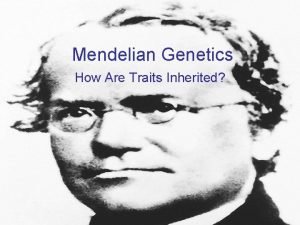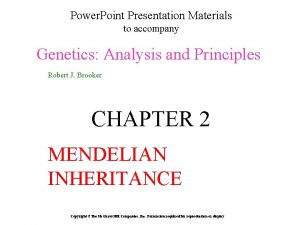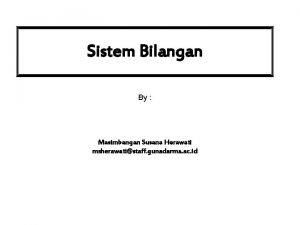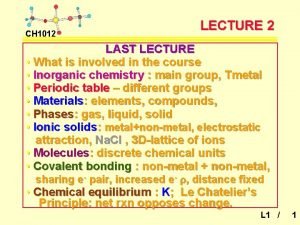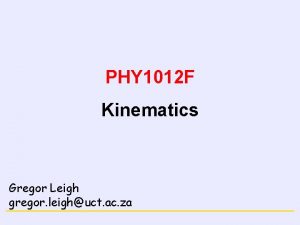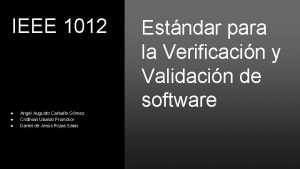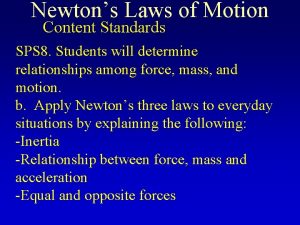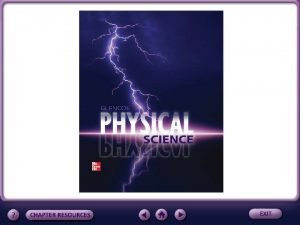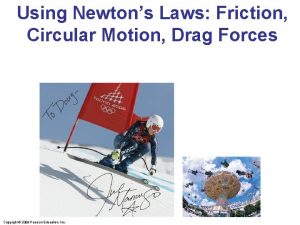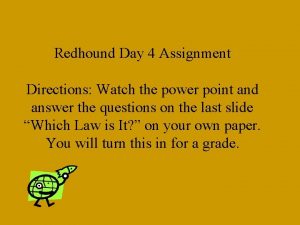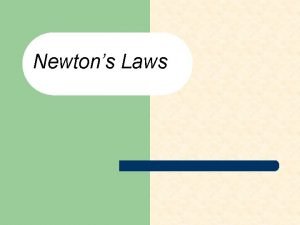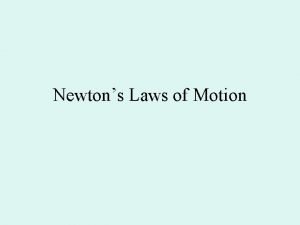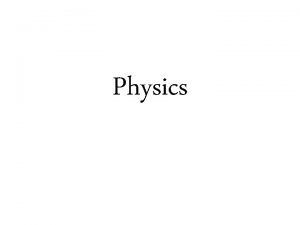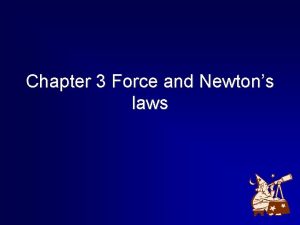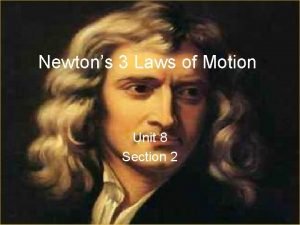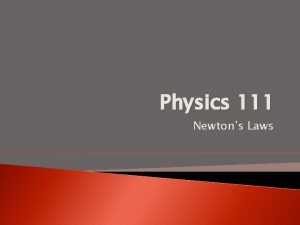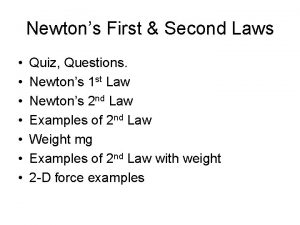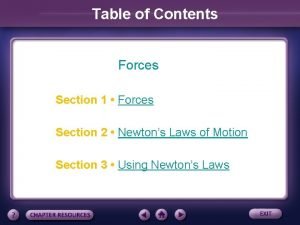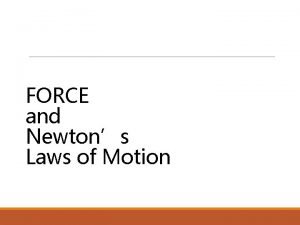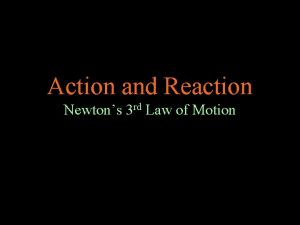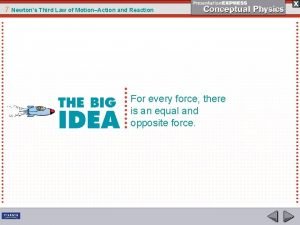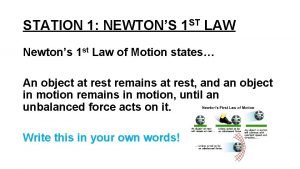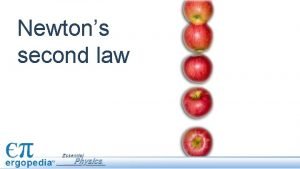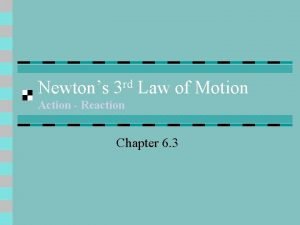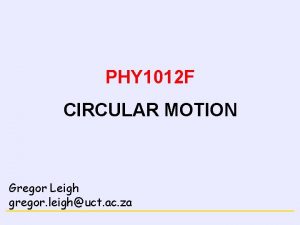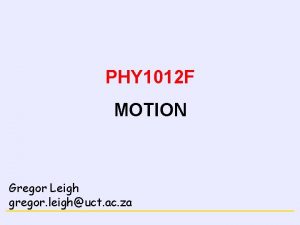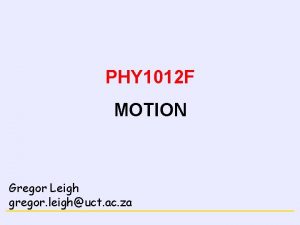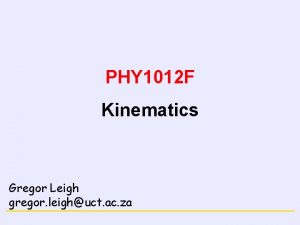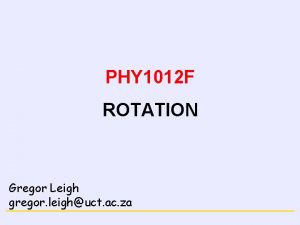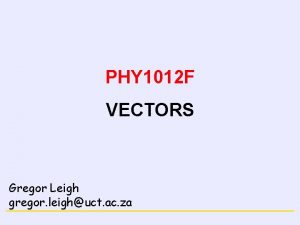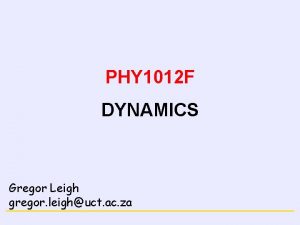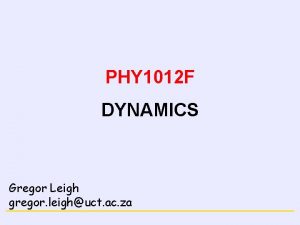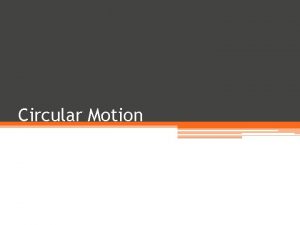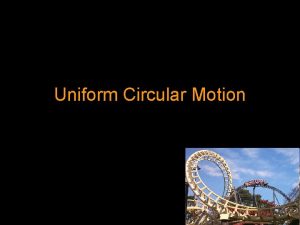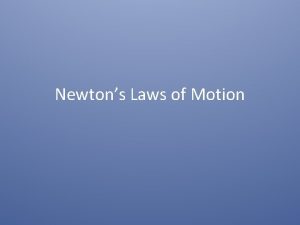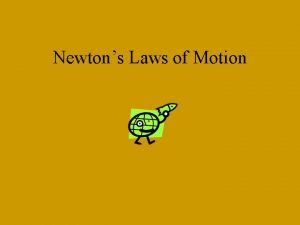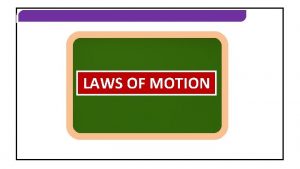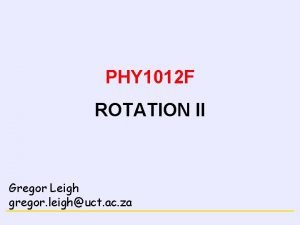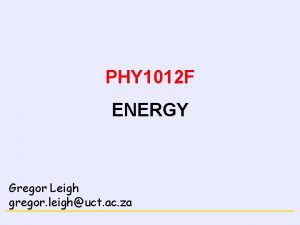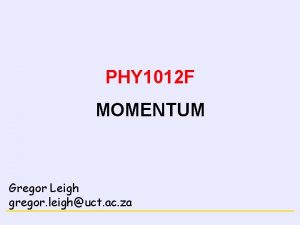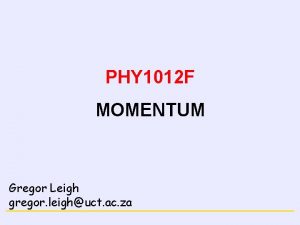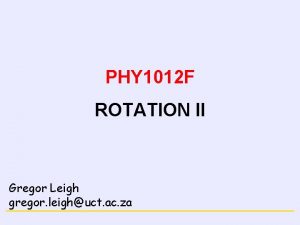NEWTONS LAWS PHY 1012 F CIRCULAR MOTION Gregor








































- Slides: 40

NEWTON’S LAWS PHY 1012 F CIRCULAR MOTION Gregor Leigh gregor. leigh@uct. ac. za MOTION IN A CIRCLE

PHY 1012 F NEWTON’S LAWS MOTION IN A CIRCLE Learning outcomes: At the end of this chapter you should be able to… Apply kinematics and dynamics knowledge, skills and techniques to circular motion. Manipulate angular quantities and formulae against the background of an angular (rtz-) coordinate system. 2

PHY 1012 F NEWTON’S LAWS MOTION IN A CIRCLE UNIFORM CIRCULAR MOTION Any particle travelling at constant speed around a circle is engaged in uniform circular motion. The magnitude of is constant, but since is everywhere tangent to the circle, its direction changes continuously. r r O r In the particle model the centre of the circle lies outside the particle, and we speak of orbital motion. Later we shall apply the same principles to the rotation or spin of extended objects about axes within themselves. 3

PHY 1012 F NEWTON’S LAWS MOTION IN A CIRCLE PERIOD The time taken for the particle to complete one revolution (rev) is called the period, T, of the motion. Hence r O E. g. Calculate the speed of a point on the rim of a CD in a 50 x drive… 4

PHY 1012 F NEWTON’S LAWS MOTION IN A CIRCLE ANGULAR POSITION It will be more convenient to describe the position of an orbiting particle in terms of polar coordinates rather than xycoordinates. y , called the angular position of the particle, … is positive when measured counterclockwise (ccw) from the positive x-axis; r s O x is conveniently measured in radians (SI unit), where 1 rad is the angle subtended at the centre by an arc length s = r; is the single time-dependent quantity of circular motion. 5

PHY 1012 F NEWTON’S LAWS MOTION IN A CIRCLE ANGULAR POSITION Notes: and s = r y ( in rad). The radian is a dimensionless unit (as is any unit of angle). r s O x 6

PHY 1012 F NEWTON’S LAWS MOTION IN A CIRCLE ANGULAR VELOCITY Change in angular position is called angular displacement, . Analogous to linear motion, the rate of change of angular position is called average angular velocity: tf = t i + t y r f O ti r i x Allowing t 0, we get (instantaneous) angular velocity: Units: [rad/s] (SI), but also [°/s, rev/s, and rev/min rpm] 7

PHY 1012 F NEWTON’S LAWS MOTION IN A CIRCLE ANGULAR VELOCITY Notes: A particle moves with uniform circular motion if and only if its angular velocity is constant. , sign by inspection… Angular velocity is positive for counterclockwise motion…. …negative for clockwise motion. >0 <0 The graphical relationships we developed for position s and velocity vs in linear motion apply equally well to angular position and angular velocity … 8

PHY 1012 F NEWTON’S LAWS MOTION IN A CIRCLE POSITION GRAPHS VELOCITY GRAPHS Angular velocity is equivalent to the slope of a -vs-t graph. (rad) Eg: A particle moves around a circle… 2 0 – 2 – 4 2 t 4 6 8 t (s) For the first 3 s the slope velocity is (rad/s) 0 2 4 6 8 t (s) – 2 9

PHY 1012 F NEWTON’S LAWS MOTION IN A CIRCLE POSITION GRAPHS VELOCITY GRAPHS Angular velocity is equivalent to the slope of a -vs-t graph. (rad) Eg: A particle moves around a circle… 2 0 – 2 2 4 6 8 t (s) – 4 Between 3 s and 4 s the slope velocity is (rad/s) 0 2 4 6 8 t (s) – 2 10

PHY 1012 F NEWTON’S LAWS MOTION IN A CIRCLE POSITION GRAPHS VELOCITY GRAPHS Angular velocity is equivalent to the slope of a -vs-t graph. (rad) Eg: A particle moves around a circle… 2 0 – 2 2 4 6 8 t (s) – 4 Between 4 s and 8 s the slope velocity is t (rad/s) 0 2 4 6 8 t (s) – 2 11

PHY 1012 F NEWTON’S LAWS MOTION IN A CIRCLE FINDING POSITION FROM VELOCITY A body’s angular position after a time interval t can be determined from its angular velocity using. Graphically, the change in angular position ( = t) is given by the area “under” a -vs-t graph: (rad/s) During the time interval 2 s to 8 s the body’s angular displacement is 2 0 t 2 4 6 8 t (s) 12

PHY 1012 F NEWTON’S LAWS MOTION IN A CIRCLE THE rtz-COORDINATE SYSTEM To facilitate the resolution of angular quantities, we introduce the rtz-coordinate system (centred on the orbiting particle and travelling around with it) in which… the r-axis (radial axis) points from the particle towards the centre of the circle; the t-axis (tangential axis) is tangent to the circle, pointing in the anticlockwise direction; the z-axis is perpendicular to the plane of motion. z z r O r t t 13

PHY 1012 F NEWTON’S LAWS MOTION IN A CIRCLE THE rtz-COORDINATE SYSTEM Viewed from above (with the z-axis pointing out of the screen) the axes are shown travelling around with the particle… t z r 14

PHY 1012 F NEWTON’S LAWS MOTION IN A CIRCLE THE rtz-COORDINATE SYSTEM Notes: As in xyz-coordinate system, the r-, t-, and z-axes are mutually perpendicular. The rtz-coordinate system is used only to resolve vector quantities associated with circular motion into radial and tangential components. The measurement of these quantities must necessarily take place in other reference frames. Given some vector in the plane of motion, making an angle of with the r-axis, r Ar = A cos At = A sin t A sin 15

PHY 1012 F NEWTON’S LAWS MOTION IN A CIRCLE VELOCITY and ANGULAR VELOCITY The velocity vector has only a tangential component, vt. t vt s = r Differentiating with respect to time… r Hence vt = r vr = 0 and vt = r vt s O r [ rad /s] vz = 0 16

PHY 1012 F NEWTON’S LAWS MOTION IN A CIRCLE ACCELERATION and ANGULAR VELOCITY Although the magnitude of remains constant in uniform circular motion, its direction changes continuously, so the particle must be accelerating. Motion diagram analysis reveals that the acceleration is centripetal. Notes: For uniform circular motion, since the lengths of successive ’s are all the same, the magnitude of is constant. These are all average velocity vectors… 17

PHY 1012 F NEWTON’S LAWS MOTION IN A CIRCLE ACCELERATION and ANGULAR VELOCITY The instantaneous velocity and acceleration vectors are everywhere at right angles to each other. During time interval t … the particle travels an arc length v t between P and P' (PP' v t); both the angular position and through angles of ; Q Q' P' r O P r turn …so OPP' ||| P'QQ' 18

PHY 1012 F NEWTON’S LAWS MOTION IN A CIRCLE ACCELERATION and ANGULAR VELOCITY In vector notation: t vt And since v = r… ar = 2 r r O ar Centripetal acceleration has only a radial component, ar … at = 0 az = 0 19

PHY 1012 F NEWTON’S LAWS MOTION IN A CIRCLE DYNAMICS OF UNIFORM CIRCULAR MOTION From Newton II… z r t O Note! As always, is simply the result of any number of forces being applied by identifiable agents. (It is NOT some new, disembodied force!) 20

PHY 1012 F NEWTON’S LAWS MOTION IN A CIRCLE DYNAMICS OF UNIFORM CIRCULAR MOTION z r t O In terms of r-, t-, and z-components: Necessarily so! 21

PHY 1012 F NEWTON’S LAWS MOTION IN A CIRCLE Determine the maximum speed at which a car can corner on an unbanked, dry tar road without skidding. z r r t O v will be a maximum when fs reaches its maximum value: fs = fs max = sn Fz = n – w = 0 n = w = mg 22

PHY 1012 F NEWTON’S LAWS MOTION IN A CIRCLE A highway curve is banked at an angle to the horizontal. Determine the maximum speed at which a car can take this corner without the assistance of friction. z t r r O nr = n sin Fz = nz – w = 0 z nz = n cos = w = mg r nz nr 23

PHY 1012 F NEWTON’S LAWS MOTION IN A CIRCLE CIRCULAR ORBITS The force which keeps satellites (including the Moon) moving in circular orbits around the Earth is nothing other than the gravitational force of the Earth on them. A near-Earth satellite will maintain its circular orbit only if its centripetal acceleration ar is equal to g. I. e. if r vorbit 24

PHY 1012 F NEWTON’S LAWS MOTION IN A CIRCLE In 1957 Earth’s first artificial satellite, Sputnik I, was put into orbit 300 km above the Earth’s surface by the USSR. How long did observers have to wait between sightings? Whereas the period of Earth’s natural satellite, the Moon (384 000 km away) is… ? ? ! The problem lies in the fact that g is only a local constant which can be used only near the surface of the Earth… 25

PHY 1012 F NEWTON’S LAWS MOTION IN A CIRCLE NEWTON’S LAW OF UNIVERSAL GRAVITATION Any two particles in the universe exert a mutually attractive force on each other which is proportional to the product of their masses and inversely proportional to the square of the distance of their separation. Notes: G is the universal gravitation constant. G = 6. 67 10– 11 N m 2/kg 2. The equation holds for extended spherical masses (e. g. planets) provided r, the distance between their centres, is large compared to their sizes. 26

PHY 1012 F NEWTON’S LAWS MOTION IN A CIRCLE NEWTON’S LAW OF UNIVERSAL GRAVITATION For a body of mass m at the surface of the Earth: But this is the body’s weight, w = mg… Hence, for Earth, (Why not 9. 80 m/s 2? ) The value of the gravitational constant on the surface of any planet, gplanet, is thus a direct consequence of the size and mass of that planet. 27

PHY 1012 F NEWTON’S LAWS MOTION IN A CIRCLE VARIATION OF g WITH HEIGHT ABOVE GROUND Height, h 0 m Example g (m/s 2) Sea level 9. 83 5 900 m Kilimanjaro 9. 81 10 000 m Jet airliner 9. 80 International Space Station 8. 85 Geosynchronous satellite 0. 22 350 000 m 35 900 000 m For a satellite a distance h above the earth’s surface: 28

PHY 1012 F NEWTON’S LAWS MOTION IN A CIRCLE CIRCULAR ORBITS vorbit We can now derive more universal formulae for any satellite: M And, since m FM on m r , 29

PHY 1012 F NEWTON’S LAWS MOTION IN A CIRCLE CIRCULAR ORBITS So the correct period of the Moon is… T = 2. 37 106 s = 27. 4 days 30

PHY 1012 F NEWTON’S LAWS MOTION IN A CIRCLE INERTIAL and GRAVITATIONAL MASS The connection between inertial mass (found by meas-uring a body’s acceleration a in response to a force F) and the gravitational mass which causes two bodies to attract each other is not immediately apparent… To date, however, the most precise experiments have been unable to determine any measurable difference between the two. Einstein’s general theory of relativity explains this principle of equivalence (minert = mgrav) as a fundamental property of space -time. 31

PHY 1012 F NEWTON’S LAWS MOTION IN A CIRCLE NON -UNIFORM CIRCULAR MOTION If the speed of an orbiting body varies, the body is exhibiting non-uniform circular motion. In such cases, in addition to centripetal acceleration, the body also has non-zero tangential acceleration: The net acceleration vector, is given by , where. at t t ar r ar at , and 32

PHY 1012 F NEWTON’S LAWS MOTION IN A CIRCLE DYNAMICS OF NON-UNIFORM CIRCULAR MOTION The resultant force (the sum of any number of individual forces) acting on an orbiting particle can always be resolved into tangential and radial components if required… t r (Fnet)t 33

PHY 1012 F NEWTON’S LAWS MOTION IN A CIRCLE VERTICAL CIRCLES Motion in a vertical circle is NOT uniform. As a result of gravity, on its way down, the body speeds up; on the way up it slows down. . . going down, at & vt are parallel; going up, at & vt are antiparallel. Only at the top and bottom is at = 0 ar at ar ar at Elsewhere, the net acceleration is given by at at ar at = 0 at . The magnitude and direction of this net acceleration change continuously in a complex way… 34

PHY 1012 F NEWTON’S LAWS MOTION IN A CIRCLE VERTICAL CIRCLES The net force, , which produces this acceleration, is made up of the body’s weight and the tension force provided by the string. Like the acceleration, varies around the circle… …but at the top and bottom, where at = 0, is centripetal. Note: At the top of the circle is the sum of and. At the bottom, is given by the difference of the two. 35

PHY 1012 F NEWTON’S LAWS MOTION IN A CIRCLE VERTICAL CIRCLES Apparent weight is actually a sensation arising from the contact forces which support you, rather than an awareness of the gravitational force of the Earth which acts simultaneously on every part of you. At the bottom of a vertical circle… r t vbot The extra force required to achieve this is what “adds to your g’s” in a bottom turn. 36

PHY 1012 F NEWTON’S LAWS MOTION IN A CIRCLE VERTICAL CIRCLES At the top of a vertical circle… vtop t r If (because of lack of speed) this term becomes too small (i. e. < w), n disappears, the body “comes unstuck” and goes into free fall. The speed at which n = 0 is called the critical speed, vc: vc 37

PHY 1012 F NEWTON’S LAWS MOTION IN A CIRCLE ACCELERATION DUE TO GRAVITY We are now in a position to understand why the measured value of g = 9. 80 m/s 2 is less than the value we calculated from Newton’s law of universal gravitation (g = 9. 83 m/s 2). Objects on the rotating Earth are in circular motion, so there must be a net force towards the centre. Thus wapp = mgapp = n < Fgrav. At mid-latitudes the reduction is about 0. 03 m/s 2, hence the measured value gapp = 9. 80 m/s 2. 38

PHY 1012 F NEWTON’S LAWS MOTION IN A CIRCLE Learning outcomes: At the end of this chapter you should be able to… Apply kinematics and dynamics knowledge, skills and techniques to circular motion. Manipulate angular quantities and formulae against the background of an angular (rtz-) coordinate system. 39

PHY 1012 F NEWTON’S LAWS MOTION IN A CIRCLE NEWTON’S LAWS The goals of Part I, Newton’s Laws, were to… Learn how to describe motion both qualitatively and quantitatively so that, ultimately, we could analyse it mathematically. Develop a “Newtonian intuition” for the explanation of motion: the connection between force and acceleration.
 Newton's laws names
Newton's laws names Colin skateboards down the sidewalk
Colin skateboards down the sidewalk Newtons first lw
Newtons first lw Newton's 3 laws of motion
Newton's 3 laws of motion Gregor mendel laws
Gregor mendel laws Gregor mendel laws
Gregor mendel laws Gregor mendel laws
Gregor mendel laws 00100 + 00111
00100 + 00111 Graduate success attributes
Graduate success attributes Ch 1012
Ch 1012 1012
1012 1012 angel
1012 angel Law of inertia examples
Law of inertia examples Section 3 using newtons laws
Section 3 using newtons laws Law of friction
Law of friction What are newtons three laws
What are newtons three laws Third law of newton
Third law of newton Newtons 3 rd law of motion
Newtons 3 rd law of motion Second law of motion examples
Second law of motion examples Newtons 1 st law
Newtons 1 st law What are newton's laws
What are newton's laws Section 3 using newtons law
Section 3 using newtons law Newton's laws 3
Newton's laws 3 An african elephant can reach heights of 13 feet
An african elephant can reach heights of 13 feet Newton's first and second law quiz
Newton's first and second law quiz Newton's laws
Newton's laws Newtons third law
Newtons third law Section 3 using newtons laws
Section 3 using newtons laws Law of inertia
Law of inertia Newton's 3rd law example
Newton's 3rd law example تسارع الجاذبية
تسارع الجاذبية Newtons 3 rd law of motion
Newtons 3 rd law of motion Newtons 3 rd law of motion
Newtons 3 rd law of motion Brainpop newton's laws of motion worksheet answer key
Brainpop newton's laws of motion worksheet answer key Newton's third law
Newton's third law What is newton's first law
What is newton's first law Newtons third law of motion
Newtons third law of motion Newton's third law
Newton's third law What's newtons second law of motion
What's newtons second law of motion Newtons 3 rd law of motion
Newtons 3 rd law of motion Newtons 3 rd law of motion
Newtons 3 rd law of motion




